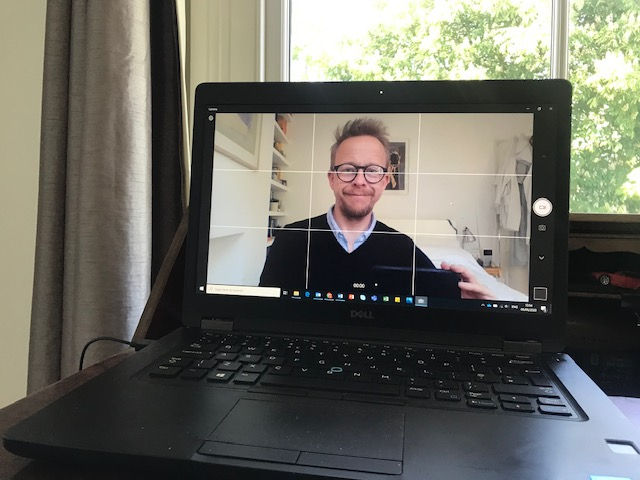Where should I look during a media interview?
- larslargo1000
- Dec 5, 2023
- 4 min read
One of the questions I've been asked most when providing media and presentation training is 'where do I look?' In other words, should an interviewee look into the camera, or at the person interviewing them?
The answer is: it depends.
In-person interview? Look at the person asking the questions
Let's imagine you're being interviewed in a TV studio opposite a presenter, or you're being interviewed face-to-face by a reporter with a camera, or you're taking part in a panel debate on a stage, where you're introduced face-to-face by a host. In these situations, the rule of thumb is to look at the person asking the questions, and talk to them.

While this sounds easy in theory, it can be more of a challenge in practice. It's likely your field of vision will not only include the interviewer but also cameras, very bright lights, microphones, teleprompters, production assistants and so on. In other words, there are many distractions. But it's crucial you remain focused on the interviewer, and your eyeline remains focused on them. The reason is this; the audience, at home or on a big conference screen, watching you give your answer, will see only you, and none of the other stuff. If you are looking at that other stuff going on, you're going to appear distracted, and your audience won't give their full attention to what you're saying.
So, the key is to look the interviewer in the eye. There's just one problem; looking someone in the eye for more than 30 seconds when speaking to them can come across as a little odd, perhaps slightly threatening. Just try it (with a friend!) Yet, that eyeline is what a TV interview demands. So here's a tip; look at the bridge of the nose of the interviewer. You won't feel weird about looking them in the eye, and your eyeline will be spot on.
If you're taking part in a live, in person, panel debate, and another panelist is speaking, you may want to turn to them and look at them while listening. It shows the audience you're interested in what's being discussed. Similarly, if you're interacting with the audience during a panel debate, you might want to turn to them and speak to them directly. But in general, if you're in the same space as the interviewer, look at them and talk to them.
On a video call? Look into the camera
The other way you may be interviewed or contribute to a panel debate is via a video call, sometimes known as 'down the line' or 'a remote feed', often using a video call provider like Zoom or Microsoft Teams. The interviewer will be in a different physical location from the interviewee.
In this case, the interviewee must look down the barrel of the camera that is feeding their image into the debate. That could be a laptop camera, often found just above the laptop's screen, or an external webcam attached to a computer.

The key to coming across as a confident and competent interviewee in these situations is to maintain eye contact with the camera. Of course, it can be easy to find yourself looking somewhere else, either at some notes you've made, or a screen showing the other participants in the debate. Unfortunately, can affect that all-important connection with your audience. You've probably seen the effect of watching yourself on a screen while on a video call; it looks like you're not speaking directly to other participants. That's OK when it's someone you know, but when trying to make an impression in a TV interview or panel debate, it can be distracting. My tip is this; get a sticky note with a big arrow drawn on it, and point the arrow to the camera. It's a visual reminder about eyeline that's blunt, but not too distracting.

The other issue when contributing on a video call is that you have to be the camera operator. You need to compose a good shot of yourself before it reaches the world. Focus on two things; lighting and composition.
Getting the lighting right
Cameras are pretty smart nowadays and can cope with most conditions, but there are some things they still struggle with. The first is lighting. Make sure there isn't a window behind you, in your picture; the camera will be confused about what it should be exposing for, and you'll end up with very little light on your face. Instead, make sure you're facing a window or a good light source. This will give your camera the light it needs to capture you looking healthy and radiant, and give the camera a better chance of being in focus.

Framing with headroom
The other thing cameras can't do is move you in frame (well, most can't). Make sure you give yourself the right amount of headroom, which is, a small amount of space between the top of your head and the top of the image on the screen. Too much headroom and you appear short. Too little headroom and you appear too big in frame, with your audience looking at your neck. Stick to the rule of thirds; your eyes should be about two thirds of the way up the screen.
Another tip is to get the camera at the same height as your eyes. This avoids the familiar problem of a camera angle that appears to be looking up the participant’s nose. Try putting your laptop on a box or a few books before composing your shot.
Summary
Together, these small changes - eyeline, lighting, framing and camera positioning - can give you the edge in an interview or a debate, and help the your message reach its audience more effectively. Remember, the fewer visual distractions for your audience, the more of what you're saying - or selling - they'll hear.



Comments